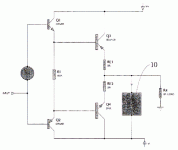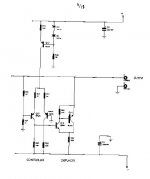Hi,
http://www.cambridgeaudio.com/assets/documents/840Awhitepaper8-2-06web.pdf
Not sure I understand it. Link may have been posted elsewhere on forum but I couldn't find it.
http://www.cambridgeaudio.com/assets/documents/840Awhitepaper8-2-06web.pdf
Not sure I understand it. Link may have been posted elsewhere on forum but I couldn't find it.
Messrs Bramble and Self state the following:
This is approach inherently flawed because the crossover glitch occurs at zero crossing only if the load is a pure resistor.
Otherwise, with an invariably reactive 'speaker load, the location of crossover will be displaced by the same angle as the phase difference between load current and voltage.
We can see that in Class B it would be better if the crossover region were anywhere else rather than where it is.
If the crossover were displaced away from its zero-crossing position, then the amplifier output would not traverse it until the output reaches a certain voltage level.
Also below this transition point the performance could be pure Class A; above it the performance normal Class B.
This is the basic Class XD principle, and it’s a very simple one: develop a topology that displaces the crossover point to one side of zero crossing.
This is approach inherently flawed because the crossover glitch occurs at zero crossing only if the load is a pure resistor.
Otherwise, with an invariably reactive 'speaker load, the location of crossover will be displaced by the same angle as the phase difference between load current and voltage.
No matter if the crossover point is displaced in time or not, you STILL get crossover distortion. Pure resistive load or not, it matters not.
Having the crossover point outside the 'normal' listening zone will decrease distortion.
Just upping the bias gives you two distortion points, something Doug Self doesn't like.
Class XD is an interesting idea, as to if its actually any good.....
Having the crossover point outside the 'normal' listening zone will decrease distortion.
Just upping the bias gives you two distortion points, something Doug Self doesn't like.
Class XD is an interesting idea, as to if its actually any good.....
remember Graham Maynard's amplifier?
This idea basically changes THD vs. power characteristic (on any load), which might be good indeed, because low level signal will be less distorted, while at high level distortion goes up.
This might give impression of "good" dynamics, 'silence' more silent and loudness more loud, old class A trick.
This idea basically changes THD vs. power characteristic (on any load), which might be good indeed, because low level signal will be less distorted, while at high level distortion goes up.
This might give impression of "good" dynamics, 'silence' more silent and loudness more loud, old class A trick.
How can Douglas Self patent an idea he has already disclosed!? 
The picture is from his homepage.
What I can see is a modulating CCS in the lower end reminding of Class XD, though I can't be really sure as I have not seen his schematics yet.
Cheers Michael
PS. EDIT: Funny the picture gets 3 times bigger when inserted here while it's only 300x400 pixels at his homepage???
The picture is from his homepage.
An externally hosted image should be here but it was not working when we last tested it.
What I can see is a modulating CCS in the lower end reminding of Class XD, though I can't be really sure as I have not seen his schematics yet.
Cheers Michael
PS. EDIT: Funny the picture gets 3 times bigger when inserted here while it's only 300x400 pixels at his homepage???
mikeks said:Ultimately, with real 'speakers, this displacement will occur anyway, and as such demonstrating that it can be obtained with resistive loads, while fascinating, is of dubious utility in practice.
I looked out my window and a pig flew by, so I guess it's safe
to agree. If Doug Self weren't so self-referencing, he could
list numerous examples of prior art, some of them mine.
numerous examples of prior art, some of them mine
please continue
dimitri said:please continue
In 1992 the early Aleph 0 used a complementary follower output
stage biased by a constant current source to the negative rail at
the SE Class A level. The complementary followers were biased
AB, that is to say the negative followers were slightly biased at
idle, and the positive followers were biased at that value plus the
current source.
A later version used an output-current modulated current source
going to the negative rail, which allowed elimination of the
negative follower, simplifying the circuit construction.
Current controlled modulation is superior to voltage controlled
in that it operates properly into load reactance. A voltage
controlled current source needs a resistive load to work as
described.
For several years the Class AB "X" series from Pass Labs has
biased the output stages with single-ended current sources,
but we also run a heavy push-pull bias on the followers. The
results are much better than using a Class B output stage with
a single-ended current source.
I think class a b ab have proven to do a good job
whats class xd first time i hear about it, and i dont
hold my breath for it, the amp that uses xd cambridge
audio azur840a is a lemon integrated amplifier which
is overly complexified by using an active control
circuitry driven by signal to displace the crossover point
dynamicly
cambridge audio say it is a form of super class ab
yeah right! sounds more like class ab to renamed
xd for marketing reasons
Nelson Pass has done this sort of thing with his pseudo
class-a amplifiers since his very early products a form
of modulated class-a by signal with dynamic efficiency
i dont know if xd is really different in operation to Nelson's
smoother's dynamic transition or if it just displaces the
crossover point a little bit
from the pics of the azur840a the amp isnt as big as pass's
monsters which would indicate some kind of pseudo pass
principle involved
from the review the sound was bassy which again would
indicate pseudo b charactiristics etc
regards
john
whats class xd first time i hear about it, and i dont
hold my breath for it, the amp that uses xd cambridge
audio azur840a is a lemon integrated amplifier which
is overly complexified by using an active control
circuitry driven by signal to displace the crossover point
dynamicly
cambridge audio say it is a form of super class ab
yeah right! sounds more like class ab to renamed
xd for marketing reasons
Nelson Pass has done this sort of thing with his pseudo
class-a amplifiers since his very early products a form
of modulated class-a by signal with dynamic efficiency
i dont know if xd is really different in operation to Nelson's
smoother's dynamic transition or if it just displaces the
crossover point a little bit
from the pics of the azur840a the amp isnt as big as pass's
monsters which would indicate some kind of pseudo pass
principle involved
from the review the sound was bassy which again would
indicate pseudo b charactiristics etc
regards
john
Hi Mikeks i am not really thrilled about it
but if you happen to have the circuit in simplified
form i wouldnt mind having a look at it
i know you are big fan of douglas self i am sorry
if i hurt your feelings with my comments here
douglas self is really good cabridge audio is lucky
to have self design the amp part of some of their
products
mikeks no1!
cheers
john
but if you happen to have the circuit in simplified
form i wouldnt mind having a look at it
i know you are big fan of douglas self i am sorry
if i hurt your feelings with my comments here
douglas self is really good cabridge audio is lucky
to have self design the amp part of some of their
products
mikeks no1!
cheers
john
mikeks said:Messrs Bramble and Self state the following:
This is approach inherently flawed because the crossover glitch occurs at zero crossing only if the load is a pure resistor.
Otherwise, with an invariably reactive 'speaker load, the location of crossover will be displaced by the same angle as the phase difference between load current and voltage.
Correct me if I'm wrong,
but I don't think that is really the point, to keep the crossover exactely at a certain place, but rather a question at WHAT power level the crossover is intruduced... just think "the first watt" and psychoacoustic masking thresholds of the ear!
Cheers Michael
For several years the Class AB "X" series from Pass Labs has biased the output stages with single-ended current sources,
but we also run a heavy push-pull bias on the followers. The results are much better than using a Class B output stage with a single-ended current source.
Hi, Mr. Pass,
I don't understand this. Heavy biased classAB is better than classB,.... OK I got this.
But I dont understand this. Is there a connection between classB or heavy biased classAB with type of VAS load? I assume single ended VAS comes from single differential (the load for VAS is CCS), and push-pull VAS (no need for CCS) comes from complementary input differential. Is the type of VAS got something to do with how much bias needed at the output stage?
Attachments
And here's the actual crossover displacement circuit for the lazy ones who don't want to dig up the patent... 
Reminds a bit of the circuit I attached in post #6, with the difference that it sensed the current while Class XD senses the voltage.
Cheers Michael
Reminds a bit of the circuit I attached in post #6, with the difference that it sensed the current while Class XD senses the voltage.
Cheers Michael
Attachments
- Status
- This old topic is closed. If you want to reopen this topic, contact a moderator using the "Report Post" button.
- Home
- Amplifiers
- Solid State
- Class XD....

 on
on
